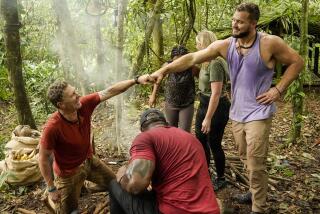TV REVIEW : ‘The Fighting Edge’
- Share via
If you can withstand the cloying super-sincerity of host Merlin Olsen for an hour, “The Fighting Edge” is a fairly interesting study of the wondrous workings of the human immune system (airing tonight at 10 and repeated Sunday at noon on Channel 9).
First there’s a quick course on how macrophages, T cells and B cells fight off antibodies and how cancer cells disguise themselves.
It’s attached to a silly and protracted football analogy (T Cells are the Joe Montanas of our immune system, etc.), but it’s all informative, if basic high school science class stuff, with plenty of good video-game graphics to make it understandable to even the slowest interior lineman.
What follows are four stories about people who overcame various breakdowns in their immune systems.
Baby Chase Cobb was born without an immune system at all, but an experimental bone marrow transplant from his dad saved him. Retiree Phil Karr looked doomed to a quick death by cancer of the immune system, but he’s lived cancer-free since 1981 after being given “monoclonal antibodies,” a new product made in a laboratory from substances produced by the immune system of mice.
Newscaster Sandra Pinckney’s nearly fatal allergic reaction to insect venom was overcome by giving her massive injections of the same venoms she’s allergic to, which, inexplicably, cause her immune system to make antibodies.
AIDS patient Dan Turner, who’s amazingly lived almost six years with the disease, attributes his continued existence to his positive mental outlook. Doctors say he has inordinately strong suppressor cells that keep the AIDS virus inside him in check.
Aside from the happy endings to four “hopeless” stories, the best part of this fourth installment of Group W’s “Lifequest” health series is the footage of a natural killer cell jumping onto a cancer cell and making it explode.
“The Fighting Edge” was written and produced by Jan Getz of KDKA in Pittsburgh.
More to Read
The complete guide to home viewing
Get Screen Gab for everything about the TV shows and streaming movies everyone’s talking about.
You may occasionally receive promotional content from the Los Angeles Times.





